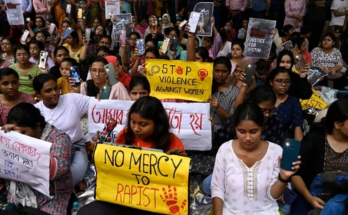The so-called liberals have the utmost concern that Hindus have become fanatics like never before under the current regime of Narendra Modi. This is partially true. To understand this we need to delve into history and some old writings.
To start with, I quote Albêrûnî who writes, “…their (Hindus) fanaticism is directed against those who do not belong to them- against all foreigners. They call them mleccha, i.e., impure, and forbid having any connection with them, be it by intermarriage or any other kind of relationship, or by sitting, eating, and drinking with them, because they think, they would be polluted. They consider anything that touches the fire and water of a foreigner impure, and no household can exist without these two elements. Besides, they never desire that a thing which once has been polluted should be purified and thus recovered, as, under ordinary circumstances, if anybody or anything has become unclean, he or it would strive to regain the state of purity. They are not allowed to receive anybody who does not belong to them, even if he wished it, or was inclined to their religion. This, too, renders any connection with them quite impossible and constitutes the widest gulf between us and them”.
This quote by Albêrûnî shows that Hindus already had an aversion to anything foreign. This “otherness” was ancient. The extent of ‘’otherness’’ described by him is as follows: “in all manners and usages, they differ from us to such a degree as to frighten their children with us, with our dress, and our ways and customs, and as to declare us to be devil’s breed, and our doings as the very opposite of all that is good and proper”.
And then he confesses that a similar depreciation of foreigners prevails not only among ‘us’ and the Hindus but is common to all nations towards each other. This generalisation makes it impossible to tag fanaticism exclusively on Hindus. The already existing antagonism between Hindus and foreigners (as we witness in Albêrûnî’s writings) was exacerbated by the so-called Shamaniyya (Buddhists). Though they cordially hated Brahmins, still they were akin to them than to others. Hindus considered Buddhists to be quenchable as well. Ironically Lord Buddha is the 9th out of 10 incarnations of the Hindu Supreme Consciousness. According to the Tantra Shastra, He belongs to the school of Atharvaveda as well as the only one after the Supreme Consciousness who has the dexterity to provide enlightenment and thereby help mankind achieve salvation. The same theory of Buddhism liable to be quenched is propounded in the story of Kumaril Bhatt who was conferred with defeating Buddhism in India (For the readers’ knowledge it must be made clear that Fa-Hsien used the term “Shaman” in a high order of the excellent preciosity for a Buddhist ascetic or priest and the Sanskrit dictionary defines Shamaniyya inter-alia liable to be appeased).
All Hindus, Shamaniyya and Jain, under the disguise of monism, made the ‘religion’ (not in the Western sense) a cloistered virtue concerned only with salvation. Salvation was achieved after death. Liberation of mankind which could have been the prime concern for any religious constitution became per incuriam and the dictum of the archimandrite became precedent. Every individual became a slave at the hands of their sect. Vasudhaiva Kutumbakam was limited to the pages of holy books wrapped under red satin. Pseudepigrapha like Manusmriti became an ignorant traducer of India’s cultural heritage. It not only justified untouchability but also slavery. In Kautilya’s Arthashastra, touching a Brahmin attracted the imputation of a Shudra’s hand.
It is indeed a fact that Hindus were tolerant of par excellence. The teachings of Jainism and Buddhism are distinctly borrowed from Upanishads which are commentary on the secrets of Vedas. Satyam Shivam Sundaram, Ahimsa Parmo Dharma, Uttishtha Jagrat Prapya Varanibodhat (Arise, awake, and stop not until the goal is reached) and the ways of equal distribution are its core teachings without which one cannot lead in life. Later, Hindus became intolerant because of foreign invasion.
It was not only Hindu and Shamaniyya under whose influence the Indian society revolved within the old ribaldry of self-inflicted injuries (viz. child sacrifice and burning alive of widows etc. considered acts of piety). The Muslim society was in an equally perilous state. Quoting Saumyendranath Tagore, who authored Raja Rammohan Roy’s biography:
“Begun much earlier, the process of decay, eating into the vitals of Indian society, was accelerated by the unbridled communal policy pursued by Aurangzeb. The financing of military expeditions against the Marathas had emptied the coffers of the Mughal Court, with the result that seats of learning, both Hindu and Muslim, were languishing; and roads, canals and other public works were in a woeful state of disrepair. The countryside was exhausted. Bereft of political hope, the Hindu society was submerged in despair. Fear cast its long shadow over the entire community which withdrew within itself and lived in the past. The unifying force of Brahmavad had yielded place to the divisive tendencies of cults, especially those based on fear.”
Until the freedom struggle commenced, history suggests that the Indians seemed to be puppet that danced to the communal agenda of the priestly class. For example, in the case of sati pratha Hindu and Muslim rulers failed miserably and even the market had its hand fastened as ‘the British Government that of laissez-faire declined to interfere with it for fear of wounding the religious susceptibilities of the people, which might lead to trouble.’
Knowledge remains the ultimate goal of any religion, but Hindus and Shamaniyya treated women as inferior in terms of understanding and never afforded them a fair opportunity to exhibit their natural capacity thereby keeping them devoid of education and entitlements. Even though we find the likes of Lilavati, Bhanumati the wives of King of Karnat and Kalidas respectively who were well versed with the entire Hindu scriptures including astrology. These ladies even found their places in the Skanda Purana. Not to forget Maitreyi, the wife of Yajnavalkya, who was imparted with the divine knowledge of the most difficult nature by her husband.
It was Bengal that cooperated with Rammohan, Ramakrishna, Vivekananda, Rabindra Nath Tagore and Subhash Chandra Bose, to name a few, and gave birth to the Renaissance and defined the original trajectory of the Hindu Dharma. Gandhi and Nehru followed suit. For Gandhi equality is the mandate of truth and truth is the Supreme Consciousness.
At a certain point in time, the guru of today’s pseudo-Hindus shamelessly associated Gandhi with Christianity as Gandhi was against the Chaturvarna (four strata of society based upon caste). French writer Roma Rolland had to come to rescue him with a loud voice that Gandhi is Hindu and “his parents were followers of Jain School of Hinduism which regards ahimsa as one of its basic principles.” Nehru showed modesty inter-alia to bring Kamla Nehru into active agitation against the foreign establishments.
In the Natya Shastra, Bharat Muni says that the meaning of a play should be interpreted as straightforward. In this context, we find that the war of Mahabharata is between the orthodoxy of the upper caste and the entitlement of the lower caste. Even Jainism and Buddhism never concentrated on social equality. Rather they focused on demeaning Brahmins and strained all their nerves establishing that Kshatriyas are superior to Brahmins. The reason could be both Vardhaman and Siddharth hailing from aristocratic Kshatriya clans; albeit their prime disciples were Brahmins.
Upinder Singh, in her book, “Ancient India, Culture of Contradictions”, writes, “In the Agganna Sutta, the Buddha declares: For those who rely on clan, the Kshatriya is the best in this world; [but] the person endowed with wisdom and [good] conduct is the best in the whole universe.”
Subhash Chandra Bose writes in his seminal work, “With the advent of the Mohammedans, a new synthesis was gradually worked out… with British rule, however, there came a new religion, a new culture and a new civilisation that did not want to blend with the old but desired to dominate the country completely…they had nothing whatsoever in common. Hence the magnitude of the revolt against the British domination of India.”
Historian J L Mehra writes on the same line, “The Arab settlers of Sindh and Multan were thoroughly Indianised. They employed Indian architects and adopted Indian architectural concepts wholesale in the matter of construction of their residences, public buildings and magnificent mosques. They adopted and patronised Indian music and other fine arts.”
J L Mehra somewhere further says, “It was, however, her [Razia Begum (1236-40) aka Razia Sultana] misfortune that she was a woman and the orthodox Muslim society, particularly, the fanatic mullahs of those days did not like that she should deviate from the traditional social norms. The proud Turkish nobles thought it beneath their dignity to be governed by a woman, especially the one who did not allow them to have a say in the state affairs.”
Allauddin Khilji who was the first and (with slightly permissible departure) the last Turkish who initiated the secular state policy by separating religion from the state based upon absolute despotism successfully exploited Muslim fanaticism in his war against Hindus whom they later called qafir. We must remember that the Bahmani kingdom made India an Islamic state with all the powers in the hands of the Muslim nobility. Some of its rulers promoted communalism among their subjects and treated non-Muslims as zimmis who had to pay jaziya tax and suffer from social and civil disabilities.
Could we dare to forget Babasahab Ambedkar who opposed theology in politics? We must confess that even today untouchability is rampant in Indian villages. Hindus were so ‘tolerant’ that they divided even animals and kept cows’ milk for upper castes and buffaloes’ for lower castes and overruled Grihya Sutra (a rulebook for households) that if Brahmins lose their fire then fire from the houses of vaishya (business class) was considered auspicious and given priority over other castes.
Since Ashoka’s first inscription until the first date of Narendra Modi in the parliament when he bowed down, India has been a nation where the entire politics was based upon theology. To say that it is ‘tolerant’ and fanaticism is the brainchild of Bharatiya Janata Party invites serious doubts. BJP has just cleared the rust and dust by ionizing the minds of Hindus that was made inert by Gandhi-Patel-Nehru trio. We must not forget that we were divided by hundreds of native states and it is our freedom fighters who brought them together for the common cause even though fanaticism prevailed bilaterally.
Thinking of these incidents, even the soul of the writer of these lines shudders to think of the Herculean task that luminaries from Raja Rammohan Roy to Nehru accomplished. But we in the 21st century are bragging that Hindus are getting intolerant!
Returning to Albêrûnî, he writes of a Hindu King who was killed at the hands of an enemy. A child was born to the King after his death. His name was Sagara. On coming of age, the young successor asked his mother about his father. She told him what had happened. He was inflamed with hatred and hearing the story he marched into the enemy’s borders and took vengeance upon them. After having tired of slaughtering, he compelled the survivors to wear their dress, which was meant as an ignominious punishment for them.
Albêrûnî writes, “When I heard of it, I felt thankful that he was gracious enough not to compel us to Indianise ourselves and to adopt Hindu dress and manners”.
So much so of Hindu tolerance!




